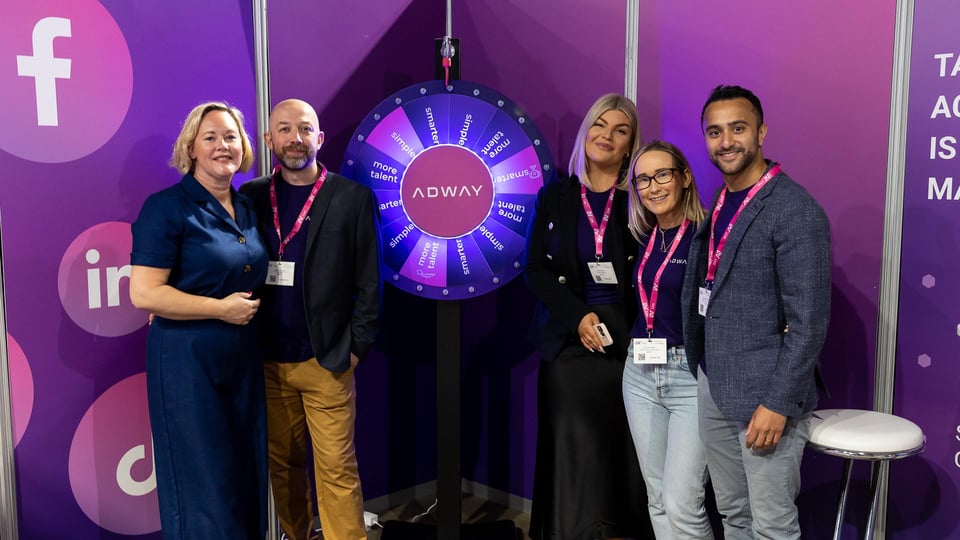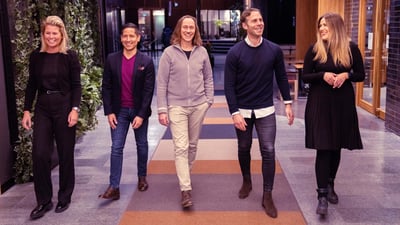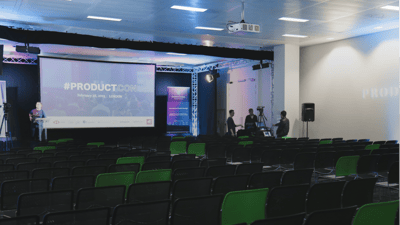Two things were clear for attendees at IHR Manchester 2022:
One, from exhibitor to attendee, everyone was excited to engage and collaborate in person after the two-year hiatus; and two, the job of the TA professional continues to evolve and assume greater responsibility.
And possibly a third – it’s hard to find good talent. Traditional methods of talent attraction no longer suffice, and in-house recruiters are adopting future-facing strategies, tactics and technologies to meet their hiring demands (not to mention the demands of their stakeholders)!
And it’s not only the quantity of talent they’re seeking. It’s clear that equity, diversity and inclusion are dominating the hearts, minds – and budgets – of talent acquisition teams. The keynote speaker, Loti Nambombe, from Nike shared his personal story of BPD, racism and remembering who he is, and the theme permeated the agenda through discussions about neurodiversity, inclusive talent attraction and inclusive salary negotiations.
If you didn’t attend IHR Manchester Live, we’ve got you covered. Here’s your espresso summary of everything you need to know!
Key themes from Manchester Live
Marketing technology
- Automated recruitment marketing
- Programmatic job advertising
- Voice technology
- Employee referral software
Equity, Diversity & Inclusion
- Inclusive salary negotiations
- Attracting neurodiverse talent
- Inclusive talent attraction
- Women and biases in leadership
Talent attraction
- Diversifying from the job boards
- Talent data and metrics
- Employer branding
- Candidate experience in recruitment
Market & economic trends
- Evolving talent landscapes
- The impact of the cost of living on recruitment
- Hybrid working and resulting innovation
An Espresso Summary of Everything You Need to Know

Keynote: BPD, Racism & Me – Remembering Who I Am
Loti Nambombe, Diversity & Mental Health Champion at Nike told his personal story of being racially targeted and abused throughout his life while coping with bipolar disease and a 15-year depression. His turning point came when he tried to take his own life and an anonymous bystander – his lifeline – talked him down and became the catalyst for his road to recovery and transformation.
Through humour, positivity and transparency, Loti answered some very poignant and personal questions from the audience, including how to talk to your children about racism, how to address someone who is suffering from mental health and how one can recognise their own biases.
Key takeaway
Being non-racist is no longer enough. Being anti-racist is what is needed to make a difference. People need to 1) Speak up 2) Make uncomfortable conversations normal 3) Become an ally and 4) Own your illness, own your differences, own it.
The Power of a Multi-Faceted Talent Attraction Strategy
79% use social media for their job search
67% use Facebook and Instagram in job search, but only 55% of recruiters do
40% use LinkedIn but 87% of recruiters do |
Richard Youngman, Head of Client Relations at networx, talked about creating a multi-channel attraction strategy including:
- Advertising / job boards / job aggregators
- Social media
- Candidate talent pools / databases
- Employee referrals
- Recruitment agencies / external support
Richard spoke about the current candidate shortage, where there are 1,288,000 live (UK) vacancies (March 2022), but no increase of active candidates on the open market. In contrast, it is estimated that as much as 80% of talent are ‘passive’ candidates and not actively looking. Optimistically, 87% of this pool would be open to finding better job opportunities if they arose. (Source: LinkedIn)
Developing a talent attraction strategy on social media can reach both the active and passive candidate pool, with specific targeting by geolocation, age, gender, education, job titles and experience. Furthermore, candidates can be targeted by interest, from groups, competitors or job-related topics or even behaviour in the devices used or purchases made.
Key takeaway
Diversify your talent attraction strategy, including focusing on LinkedIn, Facebook and Instagram for sponsored, geolocation advertising to reach passive talent pools.
Attracting and Advertising for Neurodiverse Talent
1 in 3 parents of autistic children have had to give up work due to lack of support
1 in 5 autistic people are in paid part- or full-time employment |
Jade Fuller, Programme Manager, Employ Autism shared the importance of reaching people with autism as a potential strategy to offset the current candidate shortage and, simply as the right thing to do. Many of the skills possessed by a person with autism, including high levels of concentration, reliability, conscientiousness, accuracy and a close attention to detail, are skills that are often requested in job adverts, and yet due to old fashioned application, interview and recruitment processes, many of these abled workers are turned away from paid work.
Jade dispelled some myths through sharing a video of personal stories from young people with autism, and espoused the benefits of a diverse workforce, including access to talent, diversity of thought and reflection of the clients and communities organisations serve.
Key takeaway
We need to change the current system by offering paid experiences of work, adapting the recruitment process, promoting good practices and training/consulting hiring managers and stakeholders to embrace the value of neurodiverse hiring.
The Candidate Experience Goes Social to Attract Top Talent
90% of 4.2bn mobile users are on social media
73% of millennials found their last role through social media
71% of recruiters say social media recruiting is effective |
Adway’s own Clair Bush and Sara Dalsfelt shared strategies to build a better digital candidate experience through social recruitment marketing. Proven to increase the quantity, quality and diversity of talent, whilst building a sustainable talent pipeline and reducing reliance on recruitment agencies and job boards, recruitment marketing enhances the candidate user experience in four steps:
- Using user experience (UX) strategies to design a high-converting experience
- Implementing an ‘always on’ candidate experience on social media
- Automating the candidate funnel for smoother, personalised journeys
- Avoiding the most common candidate experience pitfalls
Clair and Sara challenged audiences to think about candidate marketing as we do e-Commerce marketing. By creating great ‘shopping experiences’ for talent, we can bring candidates through the experience, activating career and employer brand messaging and bringing it all into the hands of your potential talent.
Talent is targeted through social media advertising just as customers are typically targeted through marketing – identifying the pain points and decision making throughout the stages of the sales funnel and delivering targeted messages to engage and nurture would-be ‘buyers’. Through a series of job ads, employee benefits, testimonials, reviews and active calls to action, potential talent is nurtured, allowing you to convert viewers into applicants.
Key takeaway
By applying marketing strategy to your talent attraction programme, you put talent at the centre of your strategy, delivering tailored experiences when, where and how your audiences want. Success can be measured from talent awareness through application, selection and hire, providing a KPI-bound talent strategy for the future.
The Science of Inclusive Talent Attraction
Dr. Marcia Goddard, Chief Corporate Officer at The Contentment Foundation helped attendees navigate through the noise of DE&I to help them identify what is factual. Through a Q&A format, Dr. Goddard discussed:
- How DE&I shapes modern business
- Research shows that innovation in business requires diversity. It doesn’t matter if, as a business you want to do it, society now expects it. Developing an inclusive culture requires psychological safety and the foundation is developing bias awareness throughout the business and hiring managers.
- Whether traditional methods of talent attraction are working
- In short, no. Job descriptions in text form and traditional interview processes create an opportunity for unconscious bias. There are 240 types of biases when making decisions that fall broadly into the categories of similarity, expedience, experience, distance and safety.
- How to engage with underrepresented and diverse audiences
- Be authentic. Most businesses provide an aspirational vision of what they want their employer brand to become, but it may not reflect the current reality. It’s ok to say that you’re not currently the most diverse but it’s important to also communicate how you want to change that.
Key takeaway
Start with internal bias training to provide a foundation in ED&I, then start small and start testing what works. Showcase your employer brand but remain authentic – otherwise it becomes a retention problem as people leave if you don’t walk your talk.
The Top Takeaways
The role of TA is evolving
Talent acquisition is so much more than recruiting. From acquisition through retention, TA teams are charged with navigating ED&I, hybrid working, the cost-of-living crisis and enhancing the candidate experience. Stakeholder demands are increasing, and TA teams are having to find new ways to deliver, including turning to technology to augment and amplify efforts.
Organisations are innovating
The pandemic expedited hybrid working and sped up innovation, particularly in talent acquisition and management. From remote interviews to workplace connectivity, there are roles created that didn’t exist two years ago and TA teams are being charged to lead the way.
Candidate experience is everything
From identifying target audiences, through the application process to onboarding, candidates are firmly at the centre of talent acquisition and organisations are listening and evolving. Employers are reaching talent through social channels and tailoring experiences based on their profile and preferences.
ED&I is a priority but more needs to be done
There is an evident awareness and willingness to make change from the TA community, however, changing ingrained (yet often unconscious) behaviours and biases amongst the wider workforce and community is challenging. It starts with education, ensuring ED&I is omnipresent on the agenda and finding progress through small – but measured and measurable – actions.
Way Simpler. Way Smarter. Way More Talent.
Adway connects you with the best talent in the market. By combining social media job advertising, automation, advanced machine learning software and data-driven human expertise, we support you in finding, engaging and converting relevant talent – all the while ensuring your employer brand presence increases to become talent’s employer of choice.









